Abstract
Based on the comprehensive research conducted on the territory of the Samara region using qualitative and quantitative methods (questionnaire, expert survey), the authors have developed the model of forming the innovative openness of the population, which has three key elements: development, testing and modification of ideas and innovation in practice. The authors propose a three-level model for the formation of innovative openness of the population. At the development stage, the authors suggest the use of qualitative and quantitative analysis of the created innovations. Quantitative analysis, according to the authors, will optimize the functioning of social institutions, and qualitative-to answer the question: whether innovation meets the needs of the population. In addition, the authors develop a model for filtering innovations, which involves the analysis of innovations from the standpoint of information accessibility, compliance with the needs of the population, trust, technical and methodological accessibility, ease of use, convenience. At the third stage – the stage of innovation implementation – the authors pay special attention to the formation of openness of the population to the introduced innovations. The process of spreading innovations from the innovative open to the innovative closed population is described in detail. The authors formulate a set of necessary recommendations aimed at reducing the resistance to innovation on the part of the population., reducing the number of "non-working" innovations, increasing public awareness of innovations.
Keywords: Innovationmodelinnovative opennesspopulationinnovation development
Introduction
Innovation has become an integral part of the modern society. The problem of adoption of innovations is not new in sociology. Tarde (2011) noted that the development of innovations and the perception of the new often take place not by means of adaptation, but in the struggle between traditions and innovations. Merton in his writings described five types of adaptation of the individual in society, among which there is innovation, which involves the use of institutionally prohibited, but often effective means to achieve the goal (Merton, Mead, Parsons, & Schutz, 1996). Bass diffuse model allows us to assess the degree of penetration of innovations due to two types of behavior - innovators and imitators (Bass, 1994). Rogers (2010) in his work singled out the main subjects - consumers of innovations - and showed that with a sufficient number of so-called “early consumers” (innovators), the process of dissemination of innovations becomes irreversible. Modern Russian realities require a new adoption of innovations by the population. In rapidly changing conditions, there is a need to form openness of the population to various innovations.
Problem Statement
The purposes of the study are:
Develop a model for filtering innovations based on the data obtained in the course of a sociological study.
Develop and describe a theoretical model for forming innovative openness of the population.
Give recommendations aimed at forming innovative openness of the population.
Research Questions
A large amount of scientific literature was devoted to issues of innovations, but the vast majority of this literature was concentrated around the innovative susceptibility of organizations and enterprises. At the same time, one of the most numerous groups of innovations is consumers - the population and it is overlooked. The development and description of the model is to search for mechanisms for forming innovative openness of the population, as well as formulating a set of recommendations for its stimulation.
Purpose of the Study
The purpose of the study is to develop and describe a theoretical model for forming innovative openness of the population. The peculiarity of this model is its three-stage nature, and its orientation to the needs of the population. In addition, this model takes into account the level of acceptability of innovations by the population - from innovative openness to innovative isolation.
Research Methods
At the first stage of the study, the authors conducted a survey among residents of the Samara region, dedicated to measuring the level of acceptability of innovations. In the course of the study, taking into account 97% of the confidence probability and ± 4% of the confidence interval, 704 respondents were interviewed who represent the population of the Samara region by gender, age and type of settlements. At the second stage, the authors conducted an expert survey, in which 70 respondents from 10 cities of the Samara region were interviewed. The sample included experts from 7 areas: political sector, including self-government bodies, law enforcement agencies; economic sector (banks, trade, consulting); education sector; healthcare sector; cultural and leisure sector; manufacturing sector; services sector.
Findings
In the course of the study, the authors came to the conclusion that before being accepted by the population, each innovation undergoes a certain filtering. The Polish sociologist Sztompka (2005) used the concept of “selection filter” to indicate the process of filtering innovation. As the scientist noted, the appearance of innovation is not a key to its success. Innovation needs to go through a very important process - filtering.
Sztompka (2005) emphasizes the fact that there is filtration of innovations in everyday life, carried out by ordinary people, and organized selection, which is implemented by specialized structures. In addition, he distinguishes between selection “from above” and “from below”. Selection mechanisms are connected depending on who proposed this innovation. For example, if innovation is proposed by the state, the filtering process is expressed in a public reaction: from the full implementation and use of innovation to active denial, which stops this innovation, or its formal existence. Innovation proposed “from below” - by the population - also undergoes selection, and filtering mechanisms are implemented by the relevant state or administrative institutions, organizations and structures.
It is worth noting that the selection filter performs two important functions. Firstly, it finds those innovations that do not meet the needs of the population. Secondly, it provides modification of raw innovations. The subject of our interest is the innovation filtering mechanism “from below”, i.e. by the population. In the course of the survey, we identified the innovation filtering model among the population.
As a result of the research, the following innovation filtering model was constructed (Figure
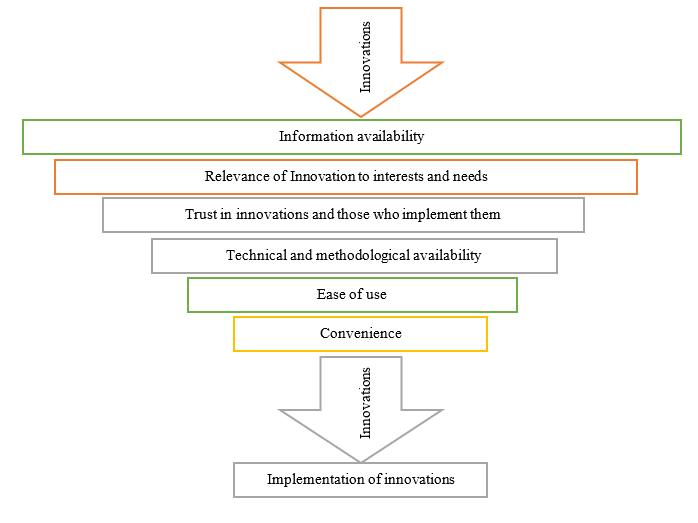
The first filter on the way to adopt innovations is information availability of these innovations. The analysis of this filter allows you to analyze in detail how actively, efficiently and comprehensively the channels are used to inform the public about innovations being implemented. According to a survey of residents of the Samara region, the main channel for receiving information on innovations is television (41%) and Internet media (34%). For example, almost 34% of respondents said that they heard for the first time about such an innovative project as Zhiguli Valley, and 43% “heard something about this project.”
Some of innovations were unknown to many respondents. Thus, 28% of respondents do not know about the territory of advanced development in the city of Togliatti; 20% of respondents do not know about the cancellation of mayoral elections; 25% of respondents have no idea of online banking services; about 20% of respondents are unfamiliar with compiling CTP policies via the Internet. Least of all respondents know about social innovations: separate collection of garbage, the event called Library Night, total dictation, geographical dictation.
The second element in the filtering mechanism is the relevance of innovations to the interests and needs of the individual. The individual can receive information about innovations through various channels. However, the lack of innovations in the everyday life of the individual, that match his interests, can lead to the fact these innovations are filtered out as unnecessary ones. So, innovations in the Unified State Exam are unlikely to interest those people who are not students, and innovations in pension provision are filtered out by the younger generation, because they do not meet its current needs.
Trust in innovations or those who implement them is a critical element in filtering innovations. Studying this filtering mechanism allows us to consider the technical side of innovations, and use the mechanisms necessary to create a positive image of innovations. So, for example, the problem of trusting such operations is on the way of the active use of online banking services. 27% of respondents express distrust in relation to this innovation; and respondents do not trust online shopping. According to The All-Russian Public Opinion Research Center, 37% of respondents oppose the creation of the electronic information system for students for safety reasons (VCIOM, 2018).
Technical and methodological availability of innovations is the ability to use innovations through existing technical means and use instruction (information on how to use these innovations). The population is open only to those innovations that are mastered very quickly and easily without any time costs for finding information. Respondents expressed the idea that they would like to have visual rows in front of their eyes that clearly demonstrate how to use these innovations. Only a few were inclined to read the instructions.
Ease of use is a critical factor in creating innovative openness. Many respondents have a fear that it would be very difficult to adapt to innovations, so they prefer old, not always convenient methods of action. According to respondents, self-service cash registers introduced in supermarkets in the Samara region not so long ago were quite difficult to use, so customers preferred to use the usual cash registers (45%), or used the new ones only in some extreme cases (14%).
Convenience and quality of innovations is an important component of innovations. According to respondents, a vivid example of “inconvenient” innovation is electronic recording of first-grade pupils. The main difficulties that parents face are the need to “watch the beginning of this recording” on the Internet at night; the program freezes and therefore the parents have to “go to school anyway and submit documents themselves.” In turn, respondents highly appreciate the convenience and quality of the provided public services: the provided information, the availability of sample applications, the information on the status of the application, and the speed of service (VCIOM, 2015).
Thus, each innovation, before becoming habitual in the life of its consumers, goes through a complex process of “rejection” or acceptance. Each filtering mechanism answers the corresponding questions that must be resolved in the development and implementation of innovations.
Based on a synthesis of data obtained in the course of scientific work, the authors built a model for forming innovative openness of the population.
This model includes three main stages, which in turn have a more complex structure. At the first stage, an innovative product or service is developed; the second stage is testing and modification, and the third stage is the implementation of innovations. The elementary structure of this model is shown in Figure
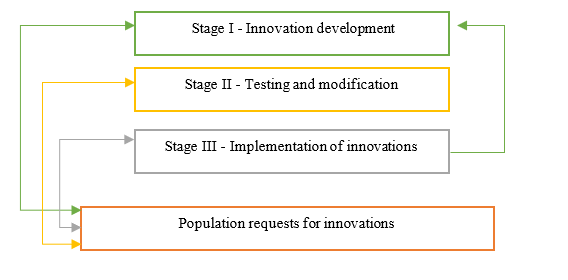
Stage I. Innovation development (Figure
Accumulated innovation projects undergo an independent assessment of experts on four components: economic and technical possibilities for implementing innovations, legal aspects of innovations, as well as sociocultural aspects.
Economic opportunities for implementing innovations mean financial costs and the return on innovations. In the absence of such, there is a search for investors who are ready to take responsibility for financial support for implementation of innovations.
Technical capabilities for implementing innovations include the possibility of developing various kinds of software and other technical aspects for functioning and implementation of innovations. If you have technical difficulties, you need to appeal to the scientific community and experts who are ready to develop and implement innovations into practice.
Analysis of the legal aspects of innovations, if necessary, includes legislative initiative and further work on creating a legal framework for each innovation.
The greatest difficulty in implementing innovations is the analysis of sociocultural aspects of functioning and implementation of these innovations. In most cases, due to the traumatic nature of Russian changes, the population is distrustful of everything new. So, we need careful preparation and formation of a sociocultural environment for easier implementation of innovation into the everyday practice of the population.
The coordination of interests of all groups of the population is equially important for the positive attitude towards innovations. In other words, the needs and requirements of all population groups should be taken into account, regardless of gender, age and other socio-economic and socio-demographic characteristics.
In order to form a sociocultural environment, civilian expertise, i.e. public (including on the Internet) discussion of the proposed innovations, consideration of the positive and negative aspects of innovations, provides for such capabilities. Such an expertise will allow developers to take into account the wishes and concerns of the population. A powerful factor for the formation of loyalty to innovations, in our opinion, is social advertising.
With a positive assessment of all four indicators of the proposed idea, innovation is developed on the basis of the innovation filtering model (Figure
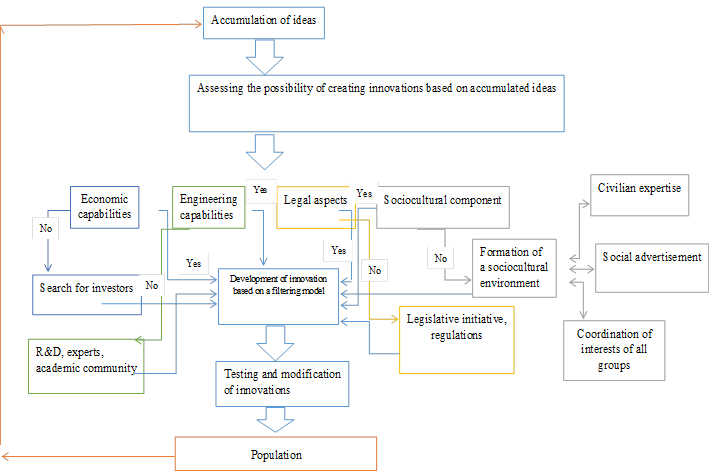
Stage II. Testing and modification of innovations (Figure
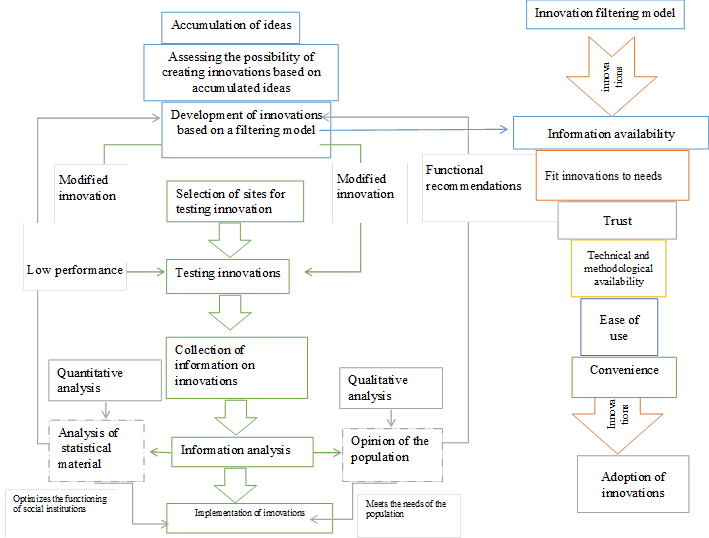
An important component at the testing stage is the collection and analysis of information on innovations, which involves both quantitative and qualitative assessment. The quantitative assessment is the analysis of statistical material that demonstrates optimization or its absence in the functioning of a particular social institution. The qualitative assessment is the so-called feedback of the population, which analyzes the indicators of need, trust, accessibility, convenience, ease of use of innovations. In case of negative indicators, innovations are to modify in accordance with the technical, legal and sociocultural aspects, as well as in accordance with the innovation filtering model. In the case of positive indicators, innovations are implemented into everyday practice.
Stage 3. Implementation of innovations (Figure
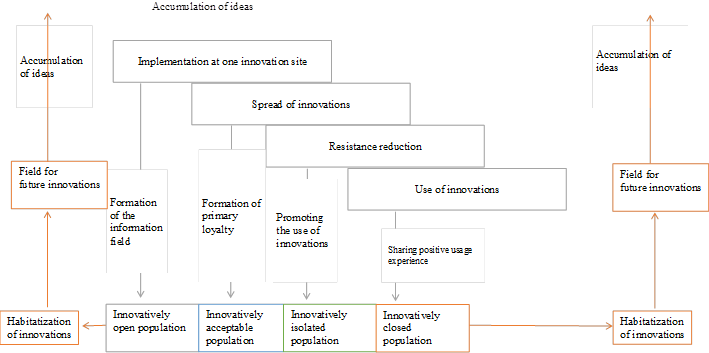
The next stage in implementing innovations is their distribution in certain regions of the country. In this case, we form the primary loyalty to innovations through a variety of social technologies. At this stage, another group of the population will be ready for innovations, which have been designated as innovatively acceptable (Rostova & Urgalkin, 2019).
The third stage includes reducing resistance among the innovation-isolated population. At this stage, methods of social and economic incentives are used to use innovations. Economic methods of promotion refers to financial benefits of innovations. An example would be a reduction in the fee for electronic transfers, as opposed to traditional transfers. Social promotion methods are motivation to use innovations through obtaining social benefits. For example, saving time, increasing prestige, saving effort, etc.
The last stage is the use of innovations, or their habitualization (Rostova & Zhelnina, 2016). At this stage, the most passive population - the innovatively closed one - is connecting to innovations. An important role for habitualization of innovations among this population group is played by the transfer of positive experience using innovations.
As a result of such a gradual implementation of innovations, various groups of the population to use innovations are stimulated, the development timelines for innovations are reduced, and habitualization is painless.
Conclusion
As a result of the study, the authors analyzed the factors forming innovative openness of the population, identified four types of habitatization of innovations, presented a model for forming innovative openness of the population, and formulated the following recommendations.
One of the main aspects in development and implementation of innovations is to take into account the needs and requests of the population. Innovations are implemented the easier, the stronger the needs for specific innovations, the better ones respond to the needs of the population. That is why we need a thorough study and assessment of existing requests.
Intelligence of innovations is also relevant. The study noted a lot of “non-working” innovations that discredit the efforts of authorities to develop the innovative society. In this regard, it is necessary to support innovations, timely eliminate shortcomings in their work, represent the “feedback” from the population and timely react to comments and suggestions.
In order to form innovative openness of the population, it is necessary to improve the interaction with society - from accumulation of ideas to implementation of innovations. Close dialogue with society will not only make it easier to implement innovations, but it will also build confidence in them.
To reduce resistance to innovations, it is recommended to use a differentiated approach when implementing these innovations. Thanks to this approach, it is possible to abandon the concentration of a large number of innovations in a separate region-innovation platform and evenly place innovations throughout the country, based on the characteristics of a particular subject, which will ease the burden on the population when developing innovations.
In order to increase public awareness of innovations, it is necessary to use a variety of social mechanisms: civilian expertise, holding innovative fairs, social advertising, and expert evaluation of innovations.
References
- Bass, F. M. (1994). The evolution of general theory of the diffusion of technological innovations. Polykarp Kusch series. Dallas, TX: The University of Texas at Dallas.
- Merton, R. K., Mead, J., Parsons, T., & Schutz, A. (1996). American sociological thought. Moscow: MSU Publishing House. [In Rus.].
- Rogers, E. M. (2010). Diffusion of innovations, 4th edn. New York, N.Y.: The Free Press.
- Rostova, A. V., & Zhelnina, V. (2016). Habitulization of innovation: The conceptualization of concepts. Search: Politics. Civics. Art. Sociology. Culture, 4(57), 15-23.
- Rostova, A. V., & Urgalkin, Y. A. (2019) Empirical indicators of innovative readiness of the population: Experience of the application of the bogardus scale. In S. Ashmarina, M. Vochozka (Eds.), Sustainable Growth and Development of Economic Systems. Contributions to Economic (pp. 135-142). Cham: Springer. DOI: 10.1007/978-3-030-11754-2_10.
- Sztompka, P. (2005). Sociology. Analysis of modern society: Translated. from Polish. Moscow: Logos.
- Tarde, G. (2011). The laws of imitation, translated from the French. Moscow: Academic project.
- VCIOM (2015). Press release No.2973. Public services online: user ratings. Retrieved from http://wciom.ru/index.php?id=236&uid=115460 Accessed: 17.09.2019.
- VCIOM (2018). Press release No.3260. Electronic information system for students: Evaluation of parents and students. Retrieved from http://wciom.ru/index.php?id=236&uid=115985 Accessed: 27.09.2019.
Copyright information

This work is licensed under a Creative Commons Attribution-NonCommercial-NoDerivatives 4.0 International License.
About this article
Publication Date
01 April 2020
Article Doi
eBook ISBN
978-1-80296-081-5
Publisher
European Publisher
Volume
82
Print ISBN (optional)
-
Edition Number
1st Edition
Pages
1-1004
Subjects
Business, innovation, management, management techniques, development studies
Cite this article as:
Rostova, A. V., Urgalkin, Y. A., & Chedzhemov, G. A. (2020). Model For Forming Innovative Openness Of The Population. In V. V. Mantulenko (Ed.), Problems of Enterprise Development: Theory and Practice, vol 82. European Proceedings of Social and Behavioural Sciences (pp. 31-39). European Publisher. https://doi.org/10.15405/epsbs.2020.04.5
